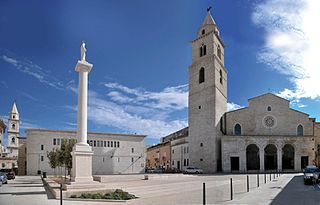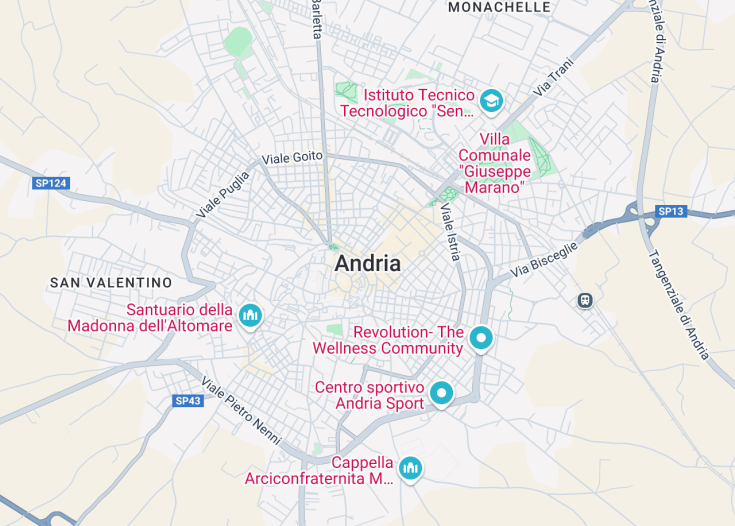Andria, nestled in Italy’s Apulia region, boasts a rich tapestry of history and culture, making it a captivating destination for travelers. Known for its stunning medieval architecture, including the famous Castel del Monte, a UNESCO World Heritage Site, Andria offers a unique glimpse into Italy’s storied past. The city is also celebrated for its vibrant culinary scene, featuring traditional dishes that highlight local ingredients. Visitors will find Andria’s streets lined with bustling markets and charming boutiques, offering a genuine experience of Italian life.
Be sure to visit Andria in early May to experience the Festa di San Riccardo, a traditional celebration with colorful parades and authentic local cuisine.
For a truly local experience, explore the surrounding countryside where you can taste Andria’s renowned olive oil and visit traditional vineyards.
Top things to do & see in Andria
Select the following sights and activities to discover best tickets and tours available in Andria.
Andria: Gateway to History and Charm
| Country | Italy |
| Time in Andria | GMT+1 |
| Language spoken | Italian |
| Population | 100,331 (source: ISTAT 2021) |
| Currency | Euro (€, EUR) |
| Airports |
|
Andria, nestled in the picturesque landscape of Italy’s Apulia region, is a city steeped in history and culture. Known for its ancient origins, Andria hosts architectural treasures such as the 12th-century Castel del Monte, recognized as a UNESCO World Heritage Site. This remarkable structure, commissioned by Emperor Frederick II, stands out for its unique octagonal shape and its storied past that intrigues historians and tourists alike.
Beyond its historical allure, Andria is a vibrant hub of agriculture, particularly known for olive oil and wine production, which contribute significantly to the local economy and gastronomy. The region’s fertile soils produce some of Italy’s finest olive oils, which are a staple in both local and international kitchens. Similarly, the vineyards surrounding Andria produce exquisite wines that are highly valued across the globe.
The city’s cultural life is rich with traditions, including annual festivals such as the Festa di Santa Rita, which transforms the city into a lively celebration of music, food, and parades. The locals, known for their warmth and hospitality, embrace visitors, offering them a taste of authentic Italian life. Art enthusiasts will find plenty to admire in local galleries and workshops that preserve and celebrate Andria’s craft heritage, including ceramics and textile art.
For those who delve into Andria’s offerings, the city not only provides a journey through captivating historical sites but also offers an opportunity to experience the vibrant street life, where modern boutiques and traditional markets line the ancient narrow streets. Here, one can encounter the true soul of Andria—a blend of history, culture, and modernity.
Where is Andria?
Andria is positioned in the Apulia region of Southern Italy, a strategic location that historically served as a bridge between the Adriatic and the rest of the peninsula.
Distances:
| Route | Distance by car | Time by car |
|---|---|---|
| Rome to Andria | 280 miles (450 km) | 4 hours 30 minutes |
| Naples to Andria | 160 miles (258 km) | 2 hours 45 minutes |
| Bari to Andria | 40 miles (64 km) | 50 minutes |
What is Andria famous for?
Andria is renowned for its Castel del Monte, built by Emperor Frederick II in the 13th century. This architectural masterpiece is celebrated for its unique geometric design and historical significance.
History
Prehistoric to Roman Era
Andria’s history traces back to prehistoric times, evidenced by the discovery of artifacts that suggest early human settlement. Archeological finds such as flint tools and pottery shards indicate that the area was inhabited during the Bronze Age. Transitioning into the Iron Age, the region saw the influences of the Daunians and the subsequent colonization by the Greeks, who explored and settled in the Apulia region. The town, however, began to form a more concrete identity during the Roman occupation, benefiting from its strategic position and the construction of the Via Traiana, a Roman road that improved its connectivity to other important settlements.
Medieval Period (9th to 15th century)
During the medieval period, Andria gained significant importance. In the 12th century, it came under the control of the Norman kings, and its fortunes greatly improved. In 1046, Andria was elevated to the status of a bishopric by Peter II, further consolidating its role as a local religious center. The construction of the Castel del Monte by Emperor Frederick II in the 13th century is a highlight of this period. The castle remains a symbol of Andria and a prime example of medieval architecture that draws scholars and tourists alike for its unique design and historical significance.
Renaissance and Early Modern Era (16th to 18th century)
The Renaissance brought about a cultural flourishing in Andria, alongside many parts of Italy. The city saw the construction of impressive palatial architectures, such as the Palazzo Ducale and numerous churches that showcase the baroque and renaissance styles. During this era, Andria was known for its production of silk and olive oil, which were traded across the region, enhancing its economic status.
Modern Period (19th century to present)
In the 19th century, Andria faced challenges due to agricultural crises and the emergence of banditry, reflective of broader regional struggles in Southern Italy. However, the unification of Italy in 1861 marked a turning point, leading to infrastructural development and integration into the national economy. In contemporary times, Andria has embraced modernity while preserving its rich historical and cultural legacy, maintaining its significance as a destination rich in history and traditions, coupled with a robust agricultural sector known particularly for its olive oil and wine production.
Visit Andria
What to see and do in Andria
Andria, steeped in history and culture, offers a wide range of sights and activities for visitors. The must-visit landmark is the Castel del Monte, a UNESCO World Heritage site, famous for its unique octagonal shape and historical significance. The city’s cathedral, Cattedrale di Santa Maria Assunta, is another notable site, showcasing exquisite architecture and art from various periods.
- Explore the old town’s narrow streets and charming squares.
- Visit the local museums like the Museo del Confetto and the Archaeological Museum.
- Enjoy traditional Apulian cuisine in local trattorias.
- Partake in olive oil and wine tasting tours in the surrounding countryside.
Festivals and Events in Andria
Andria hosts a variety of cultural and traditional events throughout the year. The Feast of St. Richard, the patron saint of Andria, in April, features processions and festivities. The summer months are ripe with celebrations including the famous ‘Festa della Madonna dei Miracoli’ in July, attracting visitors with its vibrant parades and religious observances. Additionally, the autumn welcomes the Olive and Wine Harvest festivals, celebrating the local produce with tastings and markets.
Best time to visit Andria
The best time to visit Andria is during spring (April to June) and early autumn (September and October). These periods offer pleasant weather, with fewer crowds and the opportunity to participate in local festivals such as the Feast of St. Richard and the Olive Harvest. These seasons also provide an excellent backdrop for exploring the natural landscapes and historical sites in comfortable temperatures.
Is Andria worth visiting?
Andria is indeed worth visiting for those who appreciate a blend of historical prowess, architectural beauty, and cultural richness. The presence of landmarks like Castel del Monte adds a unique historical and architectural allure. Furthermore, the vibrant local festivals and the exquisite Apulian cuisine provide an immersive Italian cultural experience. Its less touristy atmosphere compared to more crowded destinations offers a more authentic glimpse into Southern Italian life.










